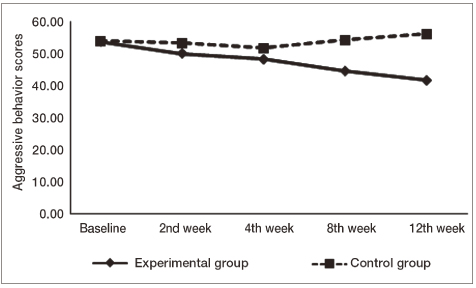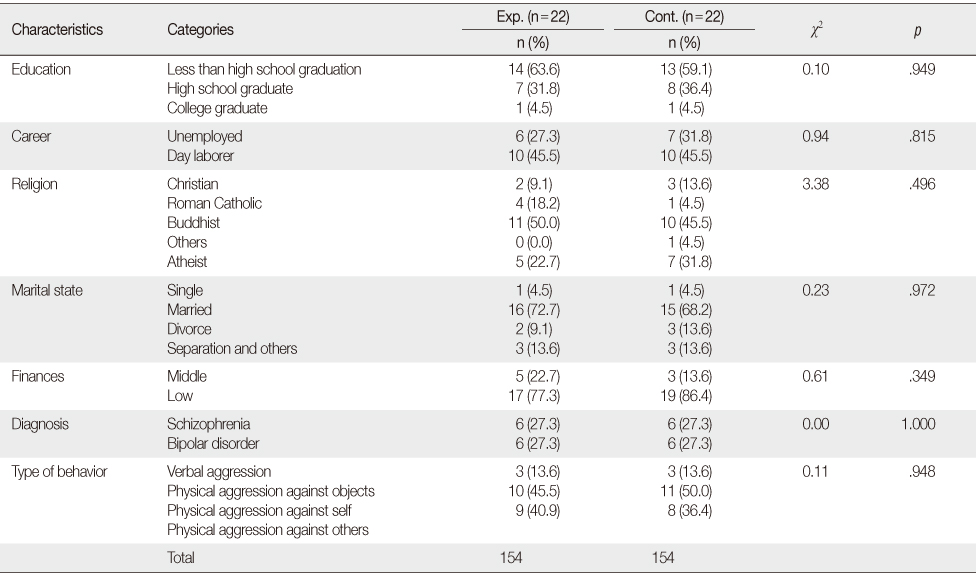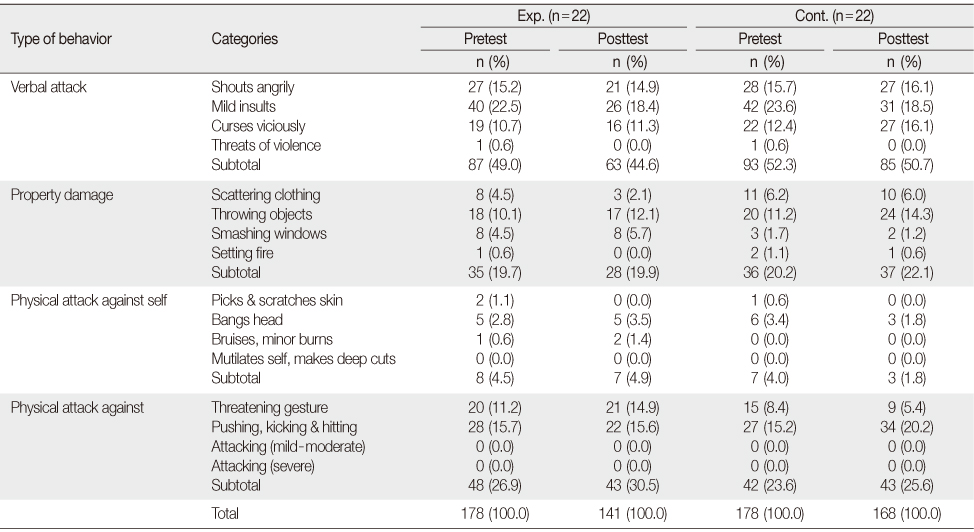Articles
- Page Path
- HOME > J Korean Acad Nurs > Volume 42(7); 2012 > Article
-
Original Article
- Modification of Severe Violent and Aggressive Behavior among Psychiatric Inpatients through the Use of a Short-Term Token Economy
- Jae Soon Park, Kyunghee Lee
-
Journal of Korean Academy of Nursing 2012;42(7):1062-1069.
DOI: https://doi.org/10.4040/jkan.2012.42.7.1062
Published online: December 31, 2012
1College of Nursing, Keimyung University, Seong Dong Mental Hospital, Daegu, Korea.
2College of Nursing, Keimyung University, Daegu, Korea.
- Address reprint requests to: Lee, Kyunghee. College of Nursing, Keimyung University, 1095 Dalgubeoldaero, Dalseo-gu, Daegu 704-701, Korea. Tel: +82-53-580-3927, Fax: 053-580-3916, khl645@kmu.ac.kr
© 2012 Korean Society of Nursing Science
- 832 Views
- 17 Download
- 4 Crossref
Abstract
-
Purpose
- Meager research has been carried out to determine the effectiveness of the token economy among patients behaving violently in mental hospitals. The purpose of this study was to examine the effectiveness of the Short-Term Token Economy (STTE) on violent behavior among chronic psychiatric in-patients.
-
Methods
- A nonequivalent control group design method was utilized. Participants in an experimental group (n=22) and control group (n=22) took part in this study from January to April, 2008. Observation on aggressive behavior among male in-patients in one hospital as a baseline was made during the week before the behavior modification program and measurement of aggressive behavior was done using the Overt Aggression Scale (OAS), which includes verbal attacks, property damage and physical attacks.
-
Results
- The aggressive behavior scores of the experimental group decreased, those of the control group, scores showed an increase after the eight-week behavior modification program utilizing STTE.
-
Conclusion
- The results of the study indicate that STTE is effective in reducing the incidence of aggressive behavior among male in-patients in psychiatric hospitals. The outcome of this study should be helpful in reducing the use of coercive measures or psychoactive medication in controlling the violent behavior among in-patients in hospitals.
INTRODUCTION
METHODS
1) Overt Aggression Scale (OAS)
2) Smile sticker as tokens
In case of collecting three stickers: A cup of coffee
In case of collecting seven stickers: A bowl of zhajiangmian, noodles with black bean sauce
In case of collecting ten stickers: Half of fried chicken
In case of collecting fifteen stickers: A walk
In case of collecting twenty stickers: An outdoor activities
In case of collecting thirty stickers: A sleeping-in
In case of the diabetic patient: A cup of Job's tears tea instead of a cup of coffee, a bowl of udong (noodles in soup) instead of a bowl of zhajiangmian were provided.
1) The staff meeting
2) A conditioned positive reinforcer
3) The training for research assistants
4) The procedure of behavior modification therapy
(1) Setting the baseline
(2) The experimental group
RESULTS
DISCUSSION
CONCLUSION
- 1. Abramowitz JS, Baucom DH, Wheaton MG, Boeding S, Fabricant LE, Paprocki C, et al. Enhancing exposure and response prevention for OCD: A couple-based approach. Behav Modif. 2012;08 10 [Epub ahead of print] http://dx.doi.org/10.1177/0145445512444596.
- 2. Ayllon T, Azrin NH. The measurement and reinforcement of behavior of psychotics. J Exp Anal Behav. 1965;8(6):357–383. http://dx.doi.org/10.1901/jeab.1965.8-357.PubMedPMC
- 3. Bowers L, Carr-Walker P, Paton J, Nijman H, Callaghan P, Allan T, et al. Changes in attitudes to personality disorder on a DSPD unit. Crim Behav Ment Health. 2005;15(3):171–183. http://dx.doi.org/10.1002/cbm.5.ArticlePubMed
- 4. Chukwujekwu DC, Stanley PC. Prevalence and correlates of aggression among psychiatric in-patients at Jos University Teaching Hospital. Niger J Clin Pract. 2011;14(2):163–167. http://dx.doi.org/10.4103/1119-3077.84007.ArticlePubMed
- 5. Corrigan PW, Yudofsky SC, Silver JM. American Psychiatric Association. Pharmacological and behavioral treatments for aggressive psychiatric inpatients. Violent behavior & mental illness: A compendium of articles from psychiatric services and hospital and community psychiatry. N. W. Washington, DC, American Psychiatric Pub. 46–54.
- 6. Gripp RF, Magaro PA. A token economy program evaluation with untreated control ward omparisons. Behav Res Ther. 1971;9(2):137–149. http://dx.doi.org/10.1016/0005 -7967-(71)90071-4.PubMed
- 7. Ha GS. Clinical characteristics of violent behaviors among inpatients in large mental hospital. J Korean Neuropsychiatr Assoc. 1993;32(5):660–668.
- 8. Han KC, Tsai YF, Chen MC, Chen YY. Violent schizophrenia patients: Caregiver burden and related factors. Hu Li Za Zhi. 2012;59(2):29–39.
- 9. Hoffmeister F. Reinforcing properties of nicocodine in the rhesus monkey. Arzneimittelforschung. 1979;29(5):811–814.PubMed
- 10. Jang SJ. Relationship between experience of patients' violent behaviors and burnout of psychiatric nurses. 2004;Seoul, Seoul National University. Unpublished master's thesis.
- 11. James DV, Fineberg NA, Shah AK, Priest RG. An increase in violence on an acute psychiatric ward. A study of associated factors. Br J Psychiatry. 1990;156:846–852. http://dx.doi.org/10.1192/bjp.156.6.846.ArticlePubMed
- 12. Kazdin AE. Issues in behavior modification with mentally retarded persons. Am J Ment Defic. 1973;78(2):134–140.PubMed
- 13. Kim YO. Analysis of nursing intervention according to type of aggressive behavior in psychiatric inpatients. 2010;Seoul, Ewha Womans University. Unpublished master's thesis.
- 14. Lippman MR, Motta RW. Effects of positive and negative reinforcement on daily living skills in chronic psychiatric patients in community residences. J Clin Psychol. 1993;49(5):654–662. http://dx.doi.org/10.1002/1097-4679(199309)49:5<654::AID-JCLP2270490507>3.0.CO;2-B.ArticlePubMed
- 15. Noble P, Rodger S. Violence by psychiatric in-patients. Br J Psychiatry. 1989;155:384–390.ArticlePubMed
- 16. Pearson M, Wilmot E, Padi M. A study of violent behaviour among in-patients in a psychiatric hospital. Br J Psychiatry. 1986;149:232–235. http://dx.doi.org/10.1192/bjp.149.2.232.ArticlePubMed
- 17. Poulsen HD, Engberg M. Validation of psychiatric patients' statements on coercive measures. Acta Psychiatr Scand. 2001;103(1):60–65. http://dx.doi.org/10.1111/j.1600-0447.2001.00146.x.ArticlePubMed
- 18. Steinert T, Wiebe C, Gebhardt RP. Aggressive behavior against self and others among first-admission patients with schizophrenia. Psychiatr Serv. 1999;50(1):85–90.ArticlePubMed
- 19. Tedeschi JT, Felson RB. Violence, aggression, and coercive actions. 1994;Washington, DC, American Psychological Association.
- 20. Walker Z, Seifert R. Violent incidents in a psychiatric intensive care unit. Br J Psychiatry. 1994;164:826–828. http://dx.doi.org/10.1192/bjp.164.6.826.ArticlePubMed
- 21. Yudofsky SC, Silver JM, Jackson W, Endicott J, Williams D. The overt aggression scale for the objective rating of verbal and physical aggression. Am J Psychiatry. 1986;143(1):35–39.ArticlePubMed
REFERENCES
Figure & Data
REFERENCES
Citations

- The Effect of Token Economy on Managing Aggression in Adults and Adolescents with Mental Disorders: A Recent Review
Fatemeh Ghojoghi, Elahe Hojati Abed, Mitra Khalaf Beigi, Esmaeil Mahboubi
Middle East Journal of Rehabilitation and Health Studies.2024;[Epub] CrossRef - Token Reinforcement, Cognitive Behavioural Therapy, Degree of Disability and Managing Aggressive Behaviour Among Pupils With Intellectual Disability
Udeme Samuel Jacob, Kehinde Rechael Adegboye, Jace Pillay
Педагогічний дискурс.2022; (33): 7. CrossRef - Patient safety in inpatient mental health settings: a systematic review
Bethan Thibaut, Lindsay Helen Dewa, Sonny Christian Ramtale, Danielle D'Lima, Sheila Adam, Hutan Ashrafian, Ara Darzi, Stephanie Archer
BMJ Open.2019; 9(12): e030230. CrossRef - The effectiveness of using reinforcements in the classroom on the academic achievement of students with intellectual disabilities
Narges Adibsereshki, Somaye Jalil Abkenar, Mohammad Ashoori, Mahmood Mirzamani
Journal of Intellectual Disabilities.2015; 19(1): 83. CrossRef

Figure 1
Homogeneity Test of Characteristics between Experimental and Control Groups (N=44)
Exp.=Experimental group; Cont.=Control group.
Homogeneity Test of Dependent Variables between Experimental and Control Groups (N=44)
Exp.=Experimental group; Cont.=Control group.
Changes in Intervention and Comparison Group by Aggressive Behavior Items (N=44)
Exp.=Experimental group; Cont.=Control group.
Simple Main Effect Analysis of Aggressive Behavior Scores (N=44)
Exp.=Experimental group; Cont.=Control group; G=Group.
Exp.=Experimental group; Cont.=Control group.
Exp.=Experimental group; Cont.=Control group.
Exp.=Experimental group; Cont.=Control group.
Exp.=Experimental group; Cont.=Control group; G=Group.
 KSNS
KSNS
 E-SUBMISSION
E-SUBMISSION





 Cite
Cite

